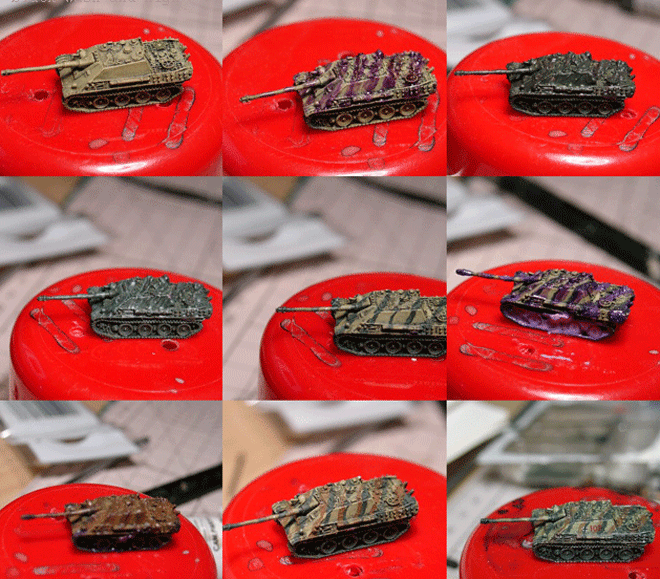
This "flat" hex didn't work out the way I'd intended, but it is still quite usable. (I didn't take "step-by-step" pictures -- I only have the end result to show...) After painting the edges dark green and the top tan, I applied a layer of Elmer's White Glue, then sprinkled on Timberline Scenery's Fine Bristlecone Green ground cover. After that dried, I soaked the hex using the water/glue mixture (a 50-50 mix of Elmer's White Glue and water, with a couple of drops of liquid dishwashing detergent to help the mixture "soak in"), then applied a layer of Woodland Scenic's Light Green Static Grass. So far, so good... Then, I sprinkled on different colors of GHQ's ground foam -- Pale Green, Light Green, Medium Green and Dark Green; then a few "pinches" of Woodland Scenic's Weeds and Burnt Grass (both very fine particles). Then -- and this was my "mistake" -- I soaked the hex again with the water/glue mixture. While it did adhere everything to the hex, it also pulled all of the static grass down to the base level of the hex -- thus negating the effect of the static grass. (sigh) So, while the hex still looks pretty good, it wasn't what I'd intended it to be.
Then, there is a small hill hex, which I am rather pleased with...


GHQ gives instructions for making Ridge hexes, using the "leftover materials" from cutting River hexes. You can make a small hill hex by cutting a piece of your "leftovers" to fit on a single hex. Round all the edges of the "hillock" using your cutting implement of choice, then glue it in place using Elmer's white glue. Use a "slurry" of Durham's Water Putty to "smooth in" the edges, then paint and finish as you would any other hex.
The small hill hex shown above was made using these steps; for finishing, I coated the "hill" area with Elmer's White Glue, then sprinkled on Timberline Scenery's Forest Floor Cover. This covering has what they call "deadfall" in it -- small "sticks", intended to simulate fallen logs on a forest floor. I broke them into smaller pieces, to be more in line with the 1:285 scale used here, as opposed to the 1:160 of "N" scale, 1:87 of "HO" scale, etc. -- which (I believe) to be Timberline's primary market. After it dried, I soaked the Forest Floor covering with a water/glue mix (as I mentioned above). Next, I "painted" the edges of the hex with white glue, then applied GHQ's Grass ground cover. After allowing time for the glue to dry, I sprinkled various shades of GHQ's ground foam, then soaked the grassy area with the water/glue mix. After that dried, I applied a variety of trees to the hill / forest area, using my trusty ol' dental pick to poke holes in the base. I then squirted a small amount of white glue in the holes, then "planted" the trees.
Hope you enjoy them!
Regards,
Tom Stockton







